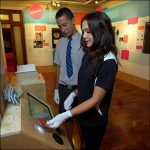
The Australian Museum showcases the history of Australian democracy through RFID technology
[ad_1]
The Museum of Democracy of Australia (MoAD) recently held an interactive exhibition using RFID technology to showcase the history of democracy in Australia. In this system, students will learn about the country’s history and government through HF RFID cards. The solution called RFID TRAIL is provided by EDM Studio, and the system was put into use for the first time in 2011.
In 2014, the system was redesigned with a new touch screen and software to optimize the flow of students. These days, the system provides an interactive experience for 700 students every day. EDM Studio has provided this solution to museums around the world. The solution uses a 13.56 MHz HF RFID function card to guide the student team to view the exhibition (each has a built-in EDM Studio RFID reader), so that students can understand the history of democracy in Australia.

MoAD is located in the original Parliament building of Australia. The museum showcases the social and political history of Australia. Darran Edmundson, director of the EDM studio, said that since the system needs to provide services to 70,000 students every year, it needs to improve reliability. He said: “They want to create an interesting learning environment for students to better understand relevant knowledge.”
Therefore, MoAD sought a technical solution to replace the traditional guide or worker-guided solution. Now, students can use this method to explore the content of the exhibition. Deborah Sulway, the museum’s learning manager, described it as “social learning.”
EDM Studio initially considered QR codes or barcodes to elicit touch screen content, but finally found that this technology is more difficult to use. On the other hand, when using RFID technology, exhibitors only need to use the badge to view the content on the screen. Edmundson said: “We want to create a sense of magic. RFID technology perfectly achieves this.”
EDM studios and museums have installed more than 50 Apple OS X touch-screen computers, each of which can display relevant historical information. At the same time, the computer can also provide matching games and polls. These computers are equipped with EDM Studio’s 13.56 MHz HF RFID reader and writer, and use an Ethernet cable to connect to the back-end server, and then the RFID TRAIL software running on the server will manage the collected RFID data. The system can also display different activities according to the age or grade of the students.
When the school team arrives, a class or a group of students is divided into two or three groups, and each group is assigned an orange RFID card with a unique ID number, and their identity information is bound to the card. These students can point the RFID card at the reader antenna and view the corresponding image on the touch screen. These data are stored in the RFID TRAIL software on the museum server.
The touch screen will show the students basic instructions, and then the team members will follow the interface instructions and answer the questions by dragging the icons. Then, the system can also display the next stop location and guide visitors to the next stop location. The system provides a navigation map, provides various directions for each group, and sends it to the next station. In this way, students can learn independently without teacher guidance.

When a computer or RFID reader fails, the museum’s content system will blacklist the site and direct the team using the device to other sites. EDM Studio can also provide remote software support for failures.
In addition, the museum can update the content at any time to meet the needs of current affairs. For example, update the corresponding question when the new prime minister takes office.
EDM Studio is currently negotiating with several museums in other parts of the world to discuss the deployment of the RFID TRAIL solution.
[ad_2]



